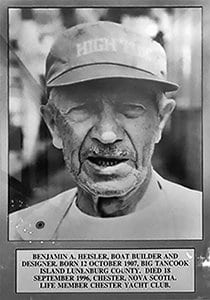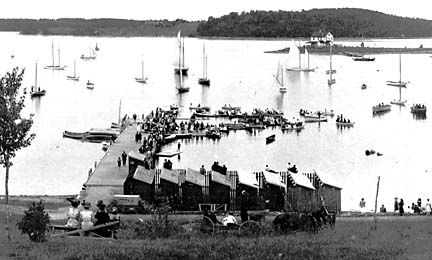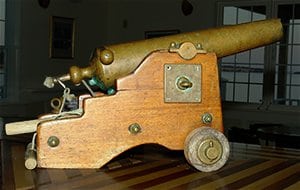Chester Yacht Club and Sailing History
The CYC Executive of 2018 would like to thank CYC member Claudette Sapp for graciously providing the club with a written a record of our club history so that it can be passed on to future generations and never forgotten.
Chester and the Tancook Islands have a long history of boat building and fishing. Boats had to be fast for the markets. The competitive spirit among builders and fishers led to sport racing off the fishing grounds. There, each could demonstrate their talents and have fun.
Visitors have been coming to Chester since 1838. In 1856, Ned Robinson, owner of Robinson’s Hotel was offering resort activities: fishing, hunting, bathing and sailing. He organized the first regular fishermen’s regatta in 1856 for all manner of boats from punts and canoes to schooners. 3000 spectators watched from the shore and enjoyed a parade followed by evening fireworks. Ned continued doing this until death in 1876 when the hotel became Columbia House. By the 1870s visitors were also enjoying sailing and racing.
Talk of establishing a yacht club became serious in 1900. L.M. Keasbey from Philadelphia assembled the charter members and proposed a constitution, bylaws, sailing rules, and schedules of races, all modeled on Halifax’s Royal Nova Scotia Yacht Squadron.
The first Chester Yacht Club race was held in 1901. The winner was “Jennie S”, built by Amos Stevens for himself, with son-in-law, Reuben Heisler at the helm. Chester Yacht Club became a reality in 1902. There were 55 members, 29 of whom were from Chester and the South Shore.
During the pre and early WWI years, local boat builders were busy and innovative. The famous Tancook schooner was designed and built on the island. Boat builders were being commissioned to build yachts for sport.
Visitors and residents shared the challenge of magnificent boats, strong winds and sailing expertise. Amos Stevens was the top builder on Tancook. His main competitor was Reuben Heisler. Races started in the Front Harbour every Saturday and during Regatta week. Within a few years, the starts were moved to the Back Harbour between Little Fish and Big Gooseberry islands. J.K. Bartlett’s boathouse became a club house.
The Hilchie boat yard on the Front Harbour, abandoned since 1894, was a perfect site for a club house. When the current owner died in 1924, members’ T.C. Boville and S.J.R. Sircom bought the property for $1,000 and entered into a lease for purchase arrangement with CYC. In 1926 the Nova Scotia legislature passed a bill recognizing the Chester Yacht Club as a “body corporate”. By 1928 the members owned the property.
In 1929 the Visitors Cup was donated for the Royal Nova Scotia Yacht Squadron winner of the Race Week Halifax to Chester race. It was an offering of gratitude to the RNSYS for their years of hospitality and good sportsmanship to CYC. Wallace MacAskill’s, Roué designed, Universal R-class sloop “Highlander” won it for each of the first five years.
In 1931, former Commodore J.K. Bartlett presented the club with a brass cannon. It served as an official race start and finish gun for 70 years until it was finally decommissioned for safety reasons. It made the trip from the US packed in the rumble seat of his daughter’s car. At the Canadian border she boldly and successfully claimed she carried no firearm.

Ben Heisler
In 1937, Benjamin Heisler, son of Reuben Heisler, launched the “Chester C” for the Heisler Boat Yard, now on the Back Harbour. The “C” boats were excellent for cruising and splendid for racing. Racers and builders cooperated in the design of this yacht which has been the most beautiful and amongst the fastest boats ever designed and built in Nova Scotia. By 1936, despite the effects of the Great Depression, CYC registered its best sailing season in years and, for two consecutive seasons, C boats won every major racing award in N.S. The Cs, with modifications, continued their winning ways well into the 21st century! (Ripple #6 and Eclipse #9).
After his retirement from racing and boat building, , joyfully shot the cannon every race until he died in 1996, well into his 9th decade. Ben was an original and well known to all. The advent of fibreglass boats prompted him to proclaim, “If God had meant boats to be in fibreglass, he would have made fibreglass trees”. His family sprinkled his ashes along the Club starting line. The cannon, as well as Ben’s photo, are displayed in the Club House.
World War II saw sailors off to war. The ladies of the home front and caretaker, Marc Dauphinee, who had been on the job since the clubhouse opened, kept the Club active. Executive decisions were taken, teas organized and fun community events built fellowship. Mothers and children continued club racing.
The building and club had survived the lean times of the depression and now, the absentee wartime members. Chester Yacht Club never suspended nor discontinued regular operation throughout the war years. Sam Allen, sailor and charter member from Montreal, wrote a memoir in the 1940s-50s in which he stated that, although a yacht club may be a delightful place for social affairs, “its primary purpose is the promotion of sailing and racing. The rattle of blocks and strain of canvas in a stout wind…must take precedence over the rattle of tea cups and the hum of conversation”. Perhaps, but CYC continued pleasant gatherings, maintained the fellowship of sailing and encouraged the development of young sailors. Funds were raised fortuitously and happily.
In 1945, designer of the iconic “Bluenose”, William Roué designed a 23-foot sloop modelled on its beautiful big sister. The new design met a great need for a family boat and a one-design racing class. Eleven were built by John Barkhouse in East Chester. Chester had the largest fleet of Bluenoses in Nova Scotia. The delightful sloop made a great resurgence in the early 21st century and the fleet remains as the largest Bluenose fleet in the province.
The advent of peace ushered in the exciting and prosperous post-war 1950s. Membership was growing, the club had a liquor license, social events at the Club were popular, and meetings and dances were crowded. While, Mrs. Payne’s renowned culinary skills were much appreciated, the members were outgrowning the venue.
Much was done to the old place inside and out. There was a great need for a steward and /or manager. Marc’s duties now extended from property maintenance to serving the bar and helping in the kitchen.
More boats, more people, and more children were sailing. By 1960, CYC hired a sailing instructor who also helped with all Junior events; teaching, races, dances, and picnics. This was the decade of the Junior program. 95 juniors were taught and supervised.
Changes took place on the water as well as on land. The convenience of fibreglass was replacing the high maintenance of woodm, and artificial fibre sails were replacing canvas. The Classic wooden boats were disappearing. Boats were being built to meet the changing rating and handicap systems. Race courses, trophies, and classes of boats had to change. Handicaps could no longer be locally determined by the boys on the verandah.
CYC had to adopt a long-term policy of growth. It began with an awareness of the need for local participation which resulted in 75 new local members.
Chester Race Week began in the 1970s at a low ebb. The local, year-round members embarked upon a major Race Week rejuvenation program. Promotion efforts included letters to, and personal contacts with, other yacht clubs and sailors. A special effort was made by Lunenburg and Chester clubs to bring back Prince’s Inlet race. Greater numbers registered and had fun! Race week parties, which had been held at private homes or on boats, were held at the club. The number of drinks dispensed through a small window on the back wall of the Clubhouse was mind-boggling. The date for Chester Race Week was fixed for the second full week in August.
Fibreglass Bluenoses were appearing. The change was accepted by the Association thus allowing boat for boat competition. Eager racers were adding new features and sails to their boats which caused the One-Design category to lose significance. The Bluenose fleet was shrinking.
An 8-foot dingy called a pram became very popular with Nova Scotia sailors. CYC held pram races on New Year’s Day. The pram extended the season into May and September. The Club was beginning it’s revival.
The first Prince’s Inlet Race from Chester to Lunenburg was held in 1926 to encourage sailing in Lunenburg. It was held again in 1948, as Chester welcomed the new Lunenburg Yacht Club, and continued intermittently until the mid-1970s. Prince’s Inlet became legendary as the final race of Chester Race Week. Yachts gathered in Lunenburg and, after a hearty LYC breakfast, raced to Chester. In Chester, spectators lined the shore to see the beautiful spinnakers on the horizon racing for home — and lunch! In 1972, 78 yachts raced back to LYC in the afternoon. By 1975, 115 started and 108 finished. Chester Yacht Club served food for 400.
By the 1980’s, the popularity of Prince’s Inlet Race had peaked. Yachts were overcrowded, sailors were often ignorant of the rules, and the alcohol flowed. The narrow passage at Indian Point was the excitement for sailors as well as the many spectators – floating or on land. Safety and liability issues were always stressed but these issues finally cancelled the race in the 1990s.
But Chester Race Week kept growing, with good fleets in all areas. The Rear Commodore was chairman of Race Week, a position requiring the patience of Job.
One year the task fell to a respected clergyman sailor. In mid-fracas, one sailor innocently asked him how things were going. Patience wearing thin, he announced – in language more befitting a sailor than an ecclesiastic – that things were “going as normal. All …..up”. Witnesses tell the story with joyful reverence. Another Rear Commodore reacted to stress by pacing the wharf and scratching his head. He paced and scratched his way right off the edge of the wharf – backwards. Luckily, his rescue was more hilarious than anxious.
There were many attempts at making Chester Race Week more efficient. The situation launched CYC into the computer age with the donation of a 400 lb. computer machine. Members were delighted to heave and push this great machine up to the third floor. Unfortunately, the dampness of the summer It was ceremoniously taken out behind Tancook and “given the big six”.
By 2001, the old CYC building was showing its age. Surveys revealed a great need for restorative and repair work. Neither patching nor delaying were options. Rotting wood, sagging steel beams and windows all needed replacing. Members were informed at the many meetings, some of which were contentious. Ballots were sent to all members. There was a fear of losing the old and its many memories without gaining anything from the new.
(After a well organized and successful fundraising campaign, renovations we’re finally undertaken in 2005 and 2006 and have managed to blend the old with the new successfully!)
But 2001 was not only about serious construction decisions; it was about preparing for a birthday celebration…
In 2002, Chester Yacht Club celebrated its 100th Anniversary!
On the Sunday of celebration week, a parade of boats sailed by the club house with past Commodores’ taking the salute. The entire community celebrated. The parade was started by the old cannon without incident. “Hayseed IV”, launched in 1912 and racing in Chester since 1924, provided one of those dramatic and memorable moments. In a heavy breeze, the 54-foot Gardner P-class sloop, still without motor, powered by the narrow space in front of the Club house with crew frantically turning winches. It was a moment from the past: “The rattle of blocks and the straining of canvas in a stout wind” (From Dr. Sam Allen’s Memoir.) Chester Brass band entertained followed by a BBQ and great fireworks.
By constantly growing and changing with the times, the Chester Yacht Club had become the most competitive racing club, with the most races per season, of any of the Atlantic Canadian clubs. Boats had changed with the times as well, as had racing expectations. Professional judges and race officers now ran the races with club volunteers. Social memberships were welcomed. Friday evening cocktails and Thursday BBQs became very popular. Junior sailing programs were filled.
Every year there are more and more sophisticated boats, more classes, more people, more juniors, more winter pot lucks, more volunteers, and more paid staff. The 75 trophies are still shiny and, for the most part, still being presented to winners.
Classic design boats, most with impressive restorations, are joining Hayseed along with the ever-increasing number of IODs. The large contingent of Bluenoses also complement the class. All these beauties must be seen! “Whim”, #7 of the Heisler C Boats, has been donated to the Maritime Museum in Halifax. Fully and magnificently restored, it was launched from its home boatyard and now sits proudly at the Museum.
Chester Race Week continues to this day with professionally designed and operated race courses. Clubs from all over the Maritimes and some from New England regularly compete. The bigger boats now start outside Chester harbour but the Classics, like days gone by, still start here.
Professional and amateur sailors alike claim Chester offers an unsurpassed racing venue. It is sailing for the entire family.
And the dumped computer? Its successor is now a small desktop that keeps up to 150 competitors organized and aware of their standings almost as soon as the last boat crosses the line.
And so it continues. Welcome to Chester Yacht Club.
Claudette Sapp
May 2018

Early Race Week at the Chester Yacht Club.

Aerial view of Chester village looking west taken in the fall of 1993. At the top left Big Gooseberry and Little Fish Islands. The Front Harbour can be seen in the bottom of the photo. The inset shows the Chester Yacht Club (red roof).
